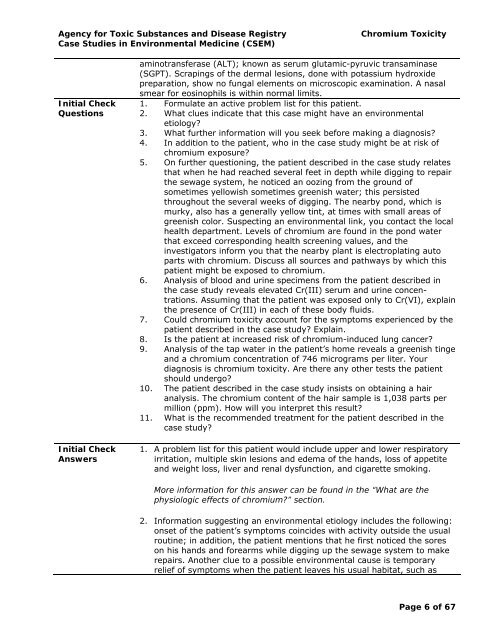(Cr) Toxicity | ATSDR - CSEM - Agency for Toxic Substances and ...
(Cr) Toxicity | ATSDR - CSEM - Agency for Toxic Substances and ...
(Cr) Toxicity | ATSDR - CSEM - Agency for Toxic Substances and ...
You also want an ePaper? Increase the reach of your titles
YUMPU automatically turns print PDFs into web optimized ePapers that Google loves.
<strong>Agency</strong> <strong>for</strong> <strong>Toxic</strong> <strong>Substances</strong> <strong>and</strong> Disease Registry Chromium <strong><strong>Toxic</strong>ity</strong><br />
Case Studies in Environmental Medicine (<strong>CSEM</strong>)<br />
Initial Check<br />
Questions<br />
Initial Check<br />
Answers<br />
aminotransferase (ALT); known as serum glutamic-pyruvic transaminase<br />
(SGPT). Scrapings of the dermal lesions, done with potassium hydroxide<br />
preparation, show no fungal elements on microscopic examination. A nasal<br />
smear <strong>for</strong> eosinophils is within normal limits.<br />
1. Formulate an active problem list <strong>for</strong> this patient.<br />
2. What clues indicate that this case might have an environmental<br />
etiology?<br />
3. What further in<strong>for</strong>mation will you seek be<strong>for</strong>e making a diagnosis?<br />
4. In addition to the patient, who in the case study might be at risk of<br />
chromium exposure?<br />
5. On further questioning, the patient described in the case study relates<br />
that when he had reached several feet in depth while digging to repair<br />
the sewage system, he noticed an oozing from the ground of<br />
sometimes yellowish sometimes greenish water; this persisted<br />
throughout the several weeks of digging. The nearby pond, which is<br />
murky, also has a generally yellow tint, at times with small areas of<br />
greenish color. Suspecting an environmental link, you contact the local<br />
health department. Levels of chromium are found in the pond water<br />
that exceed corresponding health screening values, <strong>and</strong> the<br />
investigators in<strong>for</strong>m you that the nearby plant is electroplating auto<br />
parts with chromium. Discuss all sources <strong>and</strong> pathways by which this<br />
patient might be exposed to chromium.<br />
6. Analysis of blood <strong>and</strong> urine specimens from the patient described in<br />
the case study reveals elevated <strong>Cr</strong>(III) serum <strong>and</strong> urine concentrations.<br />
Assuming that the patient was exposed only to <strong>Cr</strong>(VI), explain<br />
the presence of <strong>Cr</strong>(III) in each of these body fluids.<br />
7. Could chromium toxicity account <strong>for</strong> the symptoms experienced by the<br />
patient described in the case study? Explain.<br />
8. Is the patient at increased risk of chromium-induced lung cancer?<br />
9. Analysis of the tap water in the patient’s home reveals a greenish tinge<br />
<strong>and</strong> a chromium concentration of 746 micrograms per liter. Your<br />
diagnosis is chromium toxicity. Are there any other tests the patient<br />
should undergo?<br />
10. The patient described in the case study insists on obtaining a hair<br />
analysis. The chromium content of the hair sample is 1,038 parts per<br />
million (ppm). How will you interpret this result?<br />
11. What is the recommended treatment <strong>for</strong> the patient described in the<br />
case study?<br />
1. A problem list <strong>for</strong> this patient would include upper <strong>and</strong> lower respiratory<br />
irritation, multiple skin lesions <strong>and</strong> edema of the h<strong>and</strong>s, loss of appetite<br />
<strong>and</strong> weight loss, liver <strong>and</strong> renal dysfunction, <strong>and</strong> cigarette smoking.<br />
More in<strong>for</strong>mation <strong>for</strong> this answer can be found in the “What are the<br />
physiologic effects of chromium?” section.<br />
2. In<strong>for</strong>mation suggesting an environmental etiology includes the following:<br />
onset of the patient’s symptoms coincides with activity outside the usual<br />
routine; in addition, the patient mentions that he first noticed the sores<br />
on his h<strong>and</strong>s <strong>and</strong> <strong>for</strong>earms while digging up the sewage system to make<br />
repairs. Another clue to a possible environmental cause is temporary<br />
relief of symptoms when the patient leaves his usual habitat, such as<br />
Page 6 of 67

















